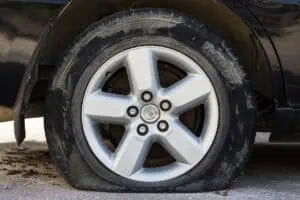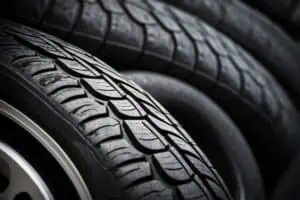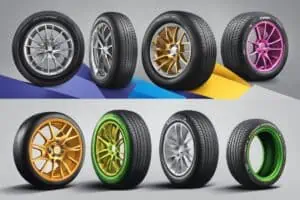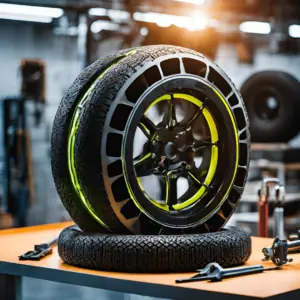As seasoned drivers, we’ve all experienced how dramatically road conditions can change with the seasons. But have you ever considered how these changes affect your tires? Let’s dive into the world of seasonal tire swaps and discover why they’re not just a good idea – they’re essential for your safety, your vehicle’s performance, and your wallet.
Why Swap Tires Seasonally?
You might be wondering, “Why can’t I just use the same tires all year round?” Well, buckle up, because we’re about to take you on a journey through the benefits of seasonal tire swaps.
1. Enhanced Safety
First and foremost, let’s talk safety. Different seasons bring different driving challenges:
- Summer: Hot pavements and occasional rain showers
- Winter: Snow, ice, and freezing temperatures
- Spring and Fall: Unpredictable mix of conditions
Each of these scenarios demands specific tire characteristics. Winter tires, for instance, use a softer rubber compound that remains flexible in cold temperatures, providing better traction on snow and ice. Summer tires, on the other hand, are designed to handle high temperatures and provide excellent dry traction.
2. Improved Performance
Think of your tires as shoes for your car. You wouldn’t wear flip-flops to run a marathon, right? The same principle applies to your vehicle. Seasonal tires are engineered to deliver optimal performance in specific conditions:
- Summer tires: Offer superior handling and braking on dry and wet roads in warm weather
- Winter tires: Provide excellent traction and shorter stopping distances on snow and ice
- All-season tires: Strike a balance for year-round use in moderate climates
3. Extended Tire Life
Here’s where your wallet comes into play. By rotating between two sets of tires, you’re effectively doubling their lifespan. How? Let’s break it down:
- Less wear and tear: Each set of tires is used for only part of the year
- Optimal performance: Tires perform best in the conditions they’re designed for, reducing unnecessary wear
- Proper storage: When not in use, tires are protected from the elements and UV radiation
The Seasonal Swap: A Step-by-Step Guide
Now that we’ve covered the ‘why’, let’s dive into the ‘how’. Here’s your roadmap to successful seasonal tire swaps:
1. Timing is Everything
- Spring: Swap winter tires for summer or all-season tires when temperatures consistently stay above 7°C (45°F)
- Fall: Make the switch back to winter tires when temperatures regularly dip below 7°C (45°F)
2. The Swap Process
- Inspect your tires: Before storage, check for any damage or unusual wear patterns
- Clean thoroughly: Use soap and water to remove dirt, road grime, and brake dust
- Dry completely: Prevent moisture-related damage by ensuring tires are completely dry
- Inflate properly: Set to the recommended pressure to maintain shape during storage
- Store wisely: More on this in the next section!
Tire Storage: Preserving Your Investment
Proper storage is crucial for maintaining your tires’ health when they’re not hitting the road. Let’s explore the best practices for each season:
Summer Storage (for Winter Tires)
- Clean and dry: Remove all dirt and moisture
- Bag it up: Place each tire in a large, airtight plastic bag
- Cool and dark: Store in a cool, dry place away from direct sunlight
- Stack or hang: If stacking, place the heaviest at the bottom; alternatively, hang them from hooks
Winter Storage (for Summer Tires)
- Wash and dry: Clean thoroughly to remove road salt and grime
- Avoid heat: Keep away from heat sources and ozone-producing equipment
- Vertical storage: Store vertically to prevent flat spots, rotating position monthly if possible
- Climate control: Aim for a consistent, moderate temperature and low humidity
Year-Round Tire Maintenance: Maximizing Longevity
Seasonal swaps are just part of the equation. To truly maximize your tires’ lifespan, follow these year-round maintenance tips:
- Regular inspections: Check for cuts, bulges, or objects lodged in the tread
- Pressure checks: Verify tire pressure monthly and before long trips
- Rotation: Rotate tires every 5,000-8,000 miles to ensure even wear
- Alignment: Have your alignment checked annually or if you notice uneven wear
- Balancing: Balance your tires when you notice vibration or after hitting a pothole
Invest in Your Safety and Savings
Seasonal tire swaps might seem like a hassle, but they’re an investment in your safety, your vehicle’s performance, and your long-term savings. By using the right tire for the right season and maintaining them properly, you’re not just extending their life – you’re enhancing your driving experience and peace of mind.
Remember, your tires are the only part of your vehicle that actually touches the road. Treat them well, and they’ll return the favor with miles of safe, comfortable, and efficient driving.
So, are you ready to make the swap and experience the difference for yourself? Your safer, smoother, and more economical rides are just a tire change away!





























